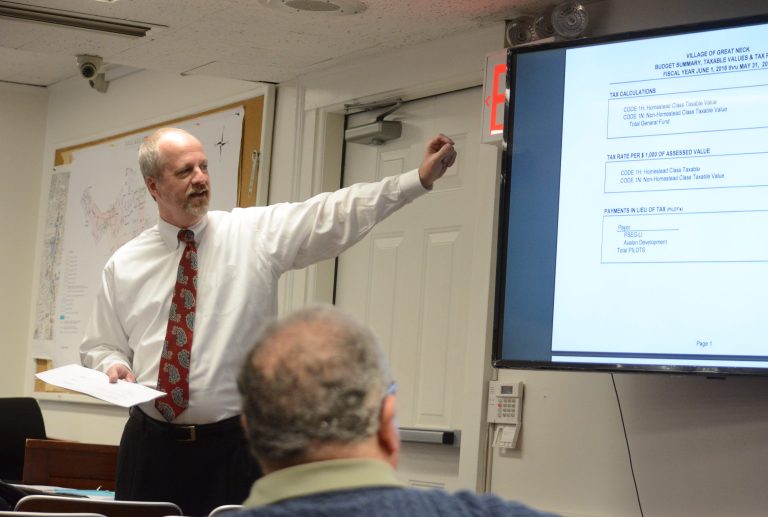
The Village of Great Neck adopted a $9.67 million budget at its board meeting Tuesday night that features no increase in the tax levy while lowering expenses.
The 2018-19 budget is $117,865, or 1.2 percent, less than the current 2017-18 budget, which is $9.79 million. More than three-quarters of the new budget comes from property taxes, which are projected to be $7.3 million.
This is the same amount as last year’s property tax levy.
“The board wanted a zero tax increase, so our tax levy will not be going up this year,” Joe Gill, the village clerk-treasurer, told residents on Tuesday.
Overall though, Gill said the typical homeowner could expect to pay about $1 per month more because the increase in value of homestead property – meaning residences – outpaced the growth in value of commercial and larger properties, despite the overall reduction in tax rates.
The collective value of the homesteads in the village went up $168.34 million or 8.31 percent, to $2.37 billion, while the average value of a home increased to $906,061 from $841,562, or 7.66 percent.
Overall, according to a budget presentation, the tax rate decrease for homesteads of 7.14 percent — or from $2.87 per $1000 of assessed value to $2.68 — comes just shy of accounting for the increase in home values.
Meanwhile, the taxable value of nonhomesteads went up $8.74 million, or 4.36 percent, to $221.72 million, with the average value of a commercial property slated to go up from $1.26 million to $1.34 million, or roughly 6 percent.
According to the budget presentation, the tax rate for commercial properties went down by 6.79 percent from $4.514 per $1000 of assessed value to $4.208, which is slightly more than the projected 6 percent increase in value.
This translates to the average commercial property paying $68.48 less per year, going down from $5,723.52 to $5,655.04, according to the presentation.
Great Neck Village Mayor Pedram Bral stressed the importance of boosting commercial property values and pursuing the revitalization of Middle Neck Road.
“That’s why it’s important for us to really increase the value of our commercial [property], because then it’s going to be the opposite — then they’re going to pay more and we’re going to pay less,” Bral said.
The second biggest revenue source comes from items like fees and fines, which are expected to be worth $1.337 million, or 13.8 percent of the budget.
Appropriated reserves, worth $482,843, meanwhile make up 5 percent of the budget and state aid, worth $326,200, makes up 3.4 percent.
General government support costs, which cover village staff and administration of the village, are budgeted to increase from $1.992 million to $2.055 million.
Public safety costs, which include fire protection services, safety inspections and traffic control items like signs, are projected to decrease from $1.815 million to $1.804 million.
The village’s ambulance contract with Vigilant Fire Company is expected to remain the same as last year, costing $275,050.
Transportation-related costs, which include street maintenance, administration, snow removal and improvements, are budgeted to rise from $1.143 million to $1.167 million.
Home and community costs are projected to rise by $11,000 from $1.193 million to $1.204 million, mostly due to refuse and garbage-related costs going up from $1.127 million to $1.138 million.
Employee benefits, including state retirement, health insurance and Social Security payments, are overall slated to decline $127,575 from $2.023 million to $1.895 million.
Payments to debt service are also slated to go down by $79,582 from $1.339 million to $1.259 million.






